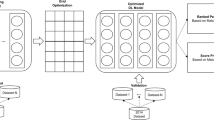Abstract
In this paper, an optimized model has been proposed exclusively for the game of cricket whereby a team of fifteen members can be chosen in an unbiased strategy. The proposed method involves a hybrid technique that uses the concept of genetic algorithm (GA) and recurrent neural networks (RNN) for selecting efficient players. Suitable preprocessing is applied to the individual players historical statistics and an initial feature matrix is generated for a player. This feature matrix is fed to the proposed mathematical function used in GA. The GA utilizes a novel fitness function for the minimization of loss-factor. This results in a refined feature matrix. This refined feature matrix is further subjected to RNN to assess a final score for the individual player. Finally, the proposed model comes up with a concurrent rank table that can be referred by the team selectors for an easy and efficient player selection for the upcoming match. It may be essentially considered that the proposed model provides results for the upcoming match or tournament only. Three different authentic datasets have been referred for the purpose of experimental evaluation of the proposed model. The results are compared with the recent match performances of each players. Surprisingly, almost equivalent results are obtained which supports the robustness of the scheme. In cases, the proposed scheme outperforms the manual team selection in terms of performance, that indicates that a slight better team could have been created in certain cases. The overall rate of accuracy in terms of predicted list of players for each match vis-a-vis the manually selected players comes out to be satisfactorily 98.5%.






Similar content being viewed by others
References
Bonidia RP, Brancher JD, Busto RM (2018) Data mining in sports: a systematic review. IEEE Latin Am Trans 16(1):232–239
Carson KWJ, Leung K (2014) Sports data mining: predicting results for the college football games. In: 18th international conference on knowledge-based and intelligent information & engineering systems—KES 2014, pp 710–719
Bialkowski A, Lucey P, Carr P, Yue Y, Sridharan S, Matthews I (2014) Large-scale analysis of soccer matches using spatiotemporal tracking data. In: IEEE international conference on data mining, 2014, pp 725–730
Janetzko H, Sacha D, Stein M, Schreck T, Keim DA, Deussen O (2014) Feature-driven visual analytics of soccer data. In: IEEE conference on visual analytics science and technology (VAST), 2014, pp 13–22
Singh T, Singla V, Bhatia P (2015) Score and winning prediction in cricket through data mining. In: 2015 international conference on soft computing techniques and implementations (ICSCTI), pp 60–66
Fister I, Fister I, Fister D, Fong S (2013) Data mining in sporting activities created by sports trackers. In: 2013 international symposium on computational and business intelligence, pp 88–91
Pileggi H, Stolper CD, Boyle JM, Stasko JT (2012) Snapshot: visualization to propel ice hockey analytics. IEEE Trans Vis Comput Graph 18(12):2819–2828
UmaMaheswari P, Rajaram M (2009) A novel approach for mining association rules on sports data using principal component analysis: for cricket match perspective. In: IEEE international advance computing conference, 2009, pp 1074–1080
Bhattacherjee S, Sahoo J, Goswami A (2015) Association rule mining approach in strategy planning for team India in ICC world cup 2015. In: Second international conference on advances in computing and communication engineering, 2015, pp 616–621
Khan RK, Manarvi I, ud din M (2009) Evaluating performance of blackcaps of New Zealand vs. global cricket teams. In: 2009 international conference on computers industrial engineering, pp 1500–1504
Neeraj Pathak HW (2016) Applications of modern classification techniques to predict the outcome of odi cricket. Procedia Comput Sci 87(Supplement C):55–60
Isha Sachin Thakare KYP, Rajesh SS (2015) Performance evaluation for sports team selection using data mining techniques. AADYA J Manag Technol 5(12):102–108
Rabah Al-Shboul JMFK, Tahir S (2017) Automated player selection for a sports team using competitive neural networks. Int J Adv Comput Sci Appl 8(8):457–460
Sankaran S (2014) Comparing pay versus performance of ipl bowlers: an application of cluster analysis. Int J Perform Anal Sport 14(1):174–187
Author information
Authors and Affiliations
Corresponding author
Additional information
Publisher's Note
Springer Nature remains neutral with regard to jurisdictional claims in published maps and institutional affiliations.
Rights and permissions
About this article
Cite this article
Vetukuri, V.S., Sethi, N. & Rajender, R. Generic model for automated player selection for cricket teams using recurrent neural networks. Evol. Intel. 14, 971–978 (2021). https://doi.org/10.1007/s12065-020-00488-4
Received:
Revised:
Accepted:
Published:
Issue Date:
DOI: https://doi.org/10.1007/s12065-020-00488-4




